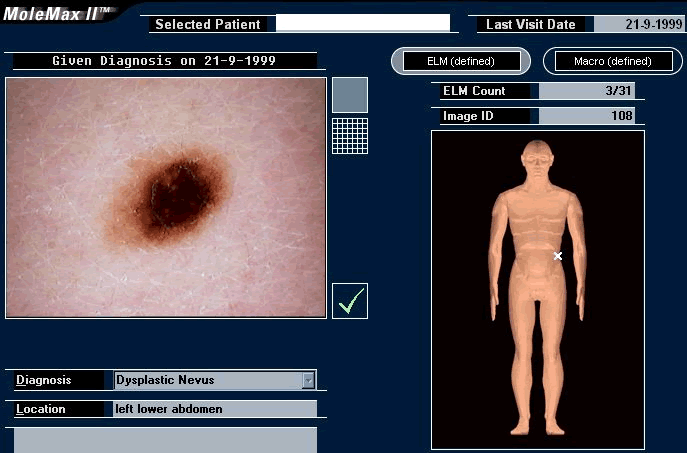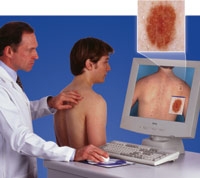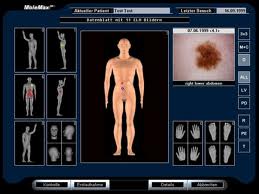Treatments
Home / Treatments / MoleMax

MoleMax Skin Cancer Detection and Management
What is a melanoma?
A melanoma is the uncontrolled growth of the pigment cells (the melanocytes) in the skin. It is a very serious type of skin cancer.
Currently, the lifetime risk of an Australian developing a melanoma is about 10% for men and 6% for women, and this risk appears to be increasing each decade. Melanoma kills over 1500 Australians every year, and yet it is one of the most curable forms of cancer.
The most effective method of treating a melanoma is by diagnosing it at an early stage of its development, when the chance for cure by surgical removal is excellent.
Skin cancer is the most common form of cancer, and Australia has one of the highest skin cancer rates in the world.
What is MoleMax skin cancer detection?
MoleMax skin cancer detection is being used by many centres around the world.
The MoleMax system enables the doctor to visually compare the images from the current year against the images taken from one or more prior years, searching for changes in your individual lesions, or the development of new lesions.
This offers the doctor a way to document your lesions without having to rely on memory or notes.

How is MoleMax skin cancer detection done?
You will be assessed by the doctor first. Fifteen to twenty images of your skin surface and moles will then be taken using a high-definition digital MoleMax camera, and the images stored in a specially developed MoleMax software program.
This procedure takes about thirty minutes.

What are the benefits of MoleMax skin cancer detection?
MoleMax skin cancer detection has a number of benefits;
- The images are magnified 30x and, using a special polarised light, the internal structure of the mole can be seen.
- The images are stored and compared at your next visit. Very early, even microscopic changes can be detected, often before they are seen by the naked eye.
- The images can be enlarged to fill the entire monitor screen, making them easier to look at.
- The pictures are digitised and stored on computer disk and therefore do not fade, curl, bend or otherwise degrade.
- Comparison of moles results in fewer unnecessary operations.
- The images can be transferred to a USB drive to take with you if moving interstate or overseas.

What do I look for at home?
Every person should regularly check the spots on their body, looking for ABCD;
- Asymmetry - if the lesion was divided, do the two halves look different?
- Border – is the border irregular?
- Colour – are there many different colours present? Is the lesion jet-black?
- Diameter – although a melanoma can be any size, a larger lesion (>6mm diameter) is more suspicious. If you have any spots that have one or more of these features, you should have them checked without delay.
If you have any spots that have one or more of these features, you should have them checked without delay.
What are the limitations of MoleMax skin cancer detection?
It is important to emphasise that there is no computer program currently available that, by itself, can accurately predict whether a particular lesion is a melanoma or not.
Even the best doctor with the best equipment cannot detect melanoma 100% of the time. The importance of looking for changes on a regular basis cannot be over stressed.
Call us now on 1300 33 87 11, or book in for a MoleMax.
Anti Wrinkle Injections
Dermal Fillers for Wrinkles
Lip Enhancement
Anti-Wrinkle Laser
Dermapen 4 Skin Needling
Blood Vessel Laser
Tattoo Removal Laser
IPL Photo Rejuvenation
SHR IPL Hair Reduction
LED Photo Rejuvenation
Mole Max
Ultrasound Fat Lipolysis
Skin Tightening
MicroSclerotherapy
MicroDermabrasion
Intraceuticals Oxygen Infusions
Carbon Facials
Peels
Permanent Makeup







